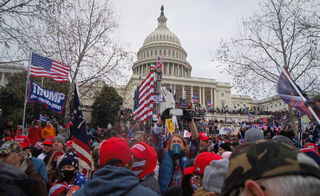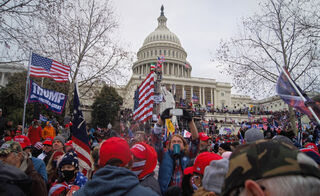
Source: Tyler Merbler, Flickr, CC BY 2.0
Last month, an intruder broke into the home of Speaker of the House Nancy Pelosi with plans to take her hostage and “break her kneecaps” and angrily confronted her husband Paul when he found that she wasn’t home. After police arrived on scene, the attacker struck Pelosi in the head with a hammer, knocking him unconscious and requiring him to be hospitalized for a skull fracture.
Rather than denouncing the attack or expressing sympathy, several political conservatives made light of the event. Arizona gubernatorial candidate Kari Lake used the opportunity to argue in favor of guns to protect children in schools during a stump speech, noting that “apparently [Pelosi’s] house doesn’t have a lot of protection” which drew laughter from the crowd she was addressing. In Texas, the Collin County Republican Party posted a photo of a holstered hammer on Facebook with the caption “open carry in San Francisco.”
Donald Trump Jr. was quick to jump into the fray, tweeting a picture of a hammer and a pair of underwear—a reference to a false conspiracy theory that Pelosi’s attacker was a gay prostitute—with the caption, “Got my Paul Pelosi Halloween costume ready.” In similarly bad taste, Louisiana Republican Congressman Clay Higgins tweeted a doctored photo of Nancy Pelosi with a black eye and the caption, “That moment you realize the nudist hippie male prostitute LSD guy was the reason your husband didn’t make it to your fundraiser.”
After Hillary Clinton condemned the attack and called attention to his attacker’s embrace of QAnon and other far-right hate speech, Elon Musk responded by retweeting the tabloid newspaper article that sparked the conspiracy theory about Pelosi’s attacker being a gay lover with the comment, “There is a tiny possibility that there is more to this story that meets the eye.”
Meanwhile, other Democrats were quick to call attention to Republicans’ failure to denounce this act of political violence. New York Congresswoman Alexandra Ocasio-Cortex tweeted, “Last year, a GOP Congressman shared a depiction of himself killing me. When the House rose to censure, [House Majority Whip Kevin McCarthy] defended him. Yesterday, a man sharing that member’s rhetoric tried to assassinate the Speaker and her spouse. What has [McCarthy] said? Nothing. This is who he is.”
Ocasio-Cortez’s tweet about “a GOP Congressman” was in reference to Republican Paul Gosar’s posting a video depicting himself as an anime character killing her back in 2021. Although Gosar was called out for the violent imagery at the time, his office dismissed it as “about fighting for the truth” and responded that “everyone needs to relax.”
Trivializing, Whataboutism, and Denialism
To many liberals, the failure to denounce political violence directed at Pelosi—a much-loathed political figure on the right—has been deafening and stands in stark contrast to Pelosi’s own expressions of sympathy for Louisiana Republican Congressman Steve Scalise after he was shot by an attacker during a baseball game in 2017.
Indeed, a kind of double standard seems to have crept into American politics. While President Obama drew widespread criticism for wearing a tan suit back in 2014 and Clinton faced a serious backlash for her “basket of deplorables” gaffe during her 2016 campaign, violent political rhetoric—mostly coming from the right—is often either trivialized and written off as harmless metaphor or countered with “whataboutism,” calling attention to Democratic Congresswoman Maxine Waters’ 2018 directive to “create a crowd” and “push back” on members of the Trump administration when encountered in public.
Denialism—that is, pretending this isn’t happening—has also been a common tactic. FOX News host Laura Ingraham recently pushed back on the idea that the political right is responsible for violent hate speech, asking, “Which Republican official or candidate has ever condoned, or in any way encouraged any type of violent assault? Can you start naming them? I can’t.”
In response, “The Daily Show” took on the “Laura Ingraham Challenge” and made a video compilation of Republican Congressman Madison Cawthorn encouraging a crowd to “lightly threaten” and “come after” their representatives, Alabama Congressman Mo Brooks declaring “today is the day American patriots start taking down names and kicking ass,” Rudy Guiliani proposing that we have “trial by combat,” President Trump encouraging crowds at his rallies to “knock the crap” out of dissenters, Florida Congressman Matt Gaetz declaring that the “swamp is not truly drained until we nail the alligators’ hides to the wall,” Georgia Congresswoman Marjorie Greene Taylor telling a crowd that “Nancy Pelosi is guilty of treason” and reminding them that “treason is a crime punishable by death,” and GOP candidates posing with guns in campaign ads and targeting Democratic opponents in Wild West-style gunfights.
Meidas Touch, a self-described “pro-democracy super PAC,” did the same with their own video highlighting McCarthy stating that “it would be hard not to hit” Nancy Pelosi with the House gavel, Gosar’s video depicting Ocasio-Cortez’s murder, Donald Trump Jr. at the shooting range boasting of “striking fear in the hearts of liberals everywhere,” Colorado Congresswoman Lauren Boebert addressing liberals with the threat “you better believe I’m coming with my Springfield XDS [handgun],” and former Trump strategist Steven Bannon talking of putting “heads on pikes” at “two corners of the [Biden] White House as a warning.”
Violent Political Rhetoric Begets Actual Violence
Faced with the facts that violent political rhetoric on the right has become an all-too-common reality, what about the claim that it’s only that—rhetorical speech that just amounts to harmless metaphor? There’s good reason to recognize that that isn’t true. Indeed, for over a decade now, Louisiana State University political science professor Nathan Kalmoe has been warning us that violent political rhetoric—even when it’s metaphorical like when we talk about political “fights,” “battles,” and “wars”—can not only further fuel anger and political polarization but also pave a path to real aggression and violence.1,2
The bright line connecting violent political rhetoric and the potential for real violence is impossible to ignore. As violent rhetoric has increased, so too has support for political violence. While polls from 2010 found that only about 16 percent of Americans condoned political violence under certain circumstances, that proportion rose to 23 percent in 2015 and peaked at 34 to 40 percent between 2020 and 2022.3,4 With this in mind, it should come as no surprise that in an act unprecedented in American history, an angry mob stormed the U.S. Capitol in 2021 looking for Pelosi and other political leaders while chanting “Hang Mike Pence!”
Working together with University of Maryland political science professor Lilliana Mason, Kalmoe has determined that actual political violence is best predicted on an individual level by having an “aggressive personality” along with “strong identification with a party” and “partisan moral disengagement”—that is, seeing members of the opposing party as “evil, less than human, and a serious threat to the nation.”5 That’s exactly what violent political rhetoric does—it dehumanizes and “others” our political opposites, painting a portrait of them as an evil enemy to be fought against, not only at the voting booth, but with real violence if need be.
With violent political rhetoric increasingly normalized as “no big deal” and real political violence increasingly regarded as potentially justified and necessary to defeat our political opponents, it’s easy to imagine that America could be headed down a path towards more violent conflict or even another civil war. Whether intentionally or not, violent political rhetoric eggs us on ever-so-farther down that path.








